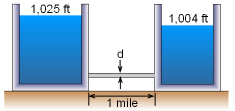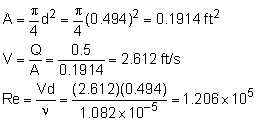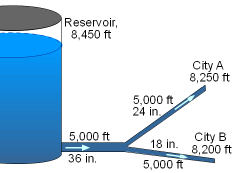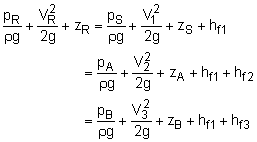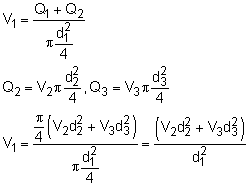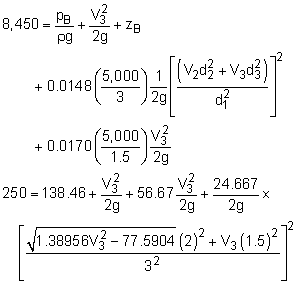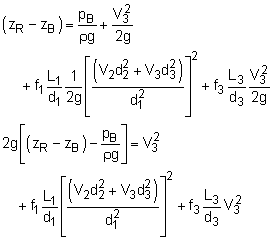| Ch 8. Incompressible and Viscous Flow | Multimedia Engineering Fluids | ||||||
|
Flow between Parallel Plates |
Couette Flow |
Viscous Flow in Pipe |
|||||
| Viscous Flow in Pipe | Case Intro | Theory | Case Solution | Example |
| Chapter |
| 1. Basics |
| 2. Fluid Statics |
| 3. Kinematics |
| 4. Laws (Integral) |
| 5. Laws (Diff.) |
| 6. Modeling/Similitude |
| 7. Inviscid |
| 8. Viscous |
| 9. External Flow |
| 10. Open-Channel |
| Appendix |
| Basic Math |
| Units |
| Basic Fluid Eqs |
| Water/Air Tables |
| Sections |
| eBooks |
| Dynamics |
| Fluids |
| Math |
| Mechanics |
| Statics |
| Thermodynamics |
| ©Kurt Gramoll |
|
|
||
| Question 1 |
||
|
|
It is desired to limit the flow between two reservoirs by using a small diameter pipe, as shown below. What diameter, d, is required for a discharge rate of 0.5 cfs (use Darcy-Weisbach). How does your answer change if you use Hazen-Williams to compute friction loss? |
|
| Solution 1 |
||
Darcy-Weisbach equation: h1 - hf = h2 where Total head does not vary with depth in a reservoir because vertical velocities are negligibly small. Therefore, z + p/ρg = he + hp = C Since we are calculating head loss due to friction over the length of the pipe, the velocity terms cancel out because V1 = V2 This leaves hf = he1 + hp1 - he2 - hp2 = 1,025 - 1,004 = 21 ft Given Q, calculating d is an iterative process. 1st: Guess a reasonable d Relative roughness = ε/d For commercial, new pipe: ε = 0.00015 ft From Moody chart, f = 0.0195 Solve Darcy-Weisbach equation for d: Use d = 0.494 ft: From Moody chart, f = 0.0195 Our solution has converged, hence d = 0.5 ft = 6 in. Using Hazen-Williams (commonly used in practice) (assume turbulent flow, valid for water at 20 oC, constant loss coefficient) where L in feet, hf in feet, and d in inches 1 gal/min = 0.002228 cfs Use C for smooth steel, C = 110 Note: This is an empirical formula, so units don't cancel. Make sure you know the units necessary for each variable. |
||
| Question 2 |
||
|
|
(1) Use the Darcy-Weisbach equation to find the flow delivered to each city (pressure at end is 60 psig) |
|
| Solution 2 |
||
(1)
Assume Re = 2 x 106 (flat portion of Moody chart) Equating (A) and (B) (pA = pB = 60 psig, as given) Equating (R) and (B): Solve for V3: V3 = 10.36 ft/s, and V2 = 8.459 ft/s Check Moody chart: f1 = 0.0155, f2 = 0.0162, and Could use new values of f and make sure it converges, but for this example,
solution. I won't. (3) 165 gallons per person per day (consumption in U. S., approximate, USGS data) 1 gpm = 0.002228 ft3/s QA = 1.717 E7 gallons per day Population A = 1.717 E7/165 = 104,000 people (2) The equations are the same to start with but You cannot assume the head loss in the pipes is the same, since the added flow to city B will have an effect on the flow through pipes 1 and 2 as well. Therefore, the new variables are d3 and V2. Since Q3 is known, V3 and d3 are related. Therefore, only one independent variable. This problem is more difficult than part (1) because f3 depends on ε/d3, so it becomes an iterative problem. Equating (A) and (B):
Equating (R) and (B): Solve and substitute in V2 from * above and solve equations, iterating for d. Guess d to start, find ε/d, V, calculate a Re and obtain f3 from Moody chart, and solve for d. Repeat until convergence. Guess d = 18 in. (same as part (1)) Based on previous velocities and new dimensions of d and new Re's: f1 = 0.0155 V2 = 8.335 ft/s Convergence, hence d3 = 18.8 inches Note: changing the flow to city B changes the flow to city A, even though the pipe to A wasn't changed. The net flow rate = (π/4)(2 ft)2(8.24
ft/s) = 25.89 cfs Therefore, there was a decrease of 440,000 gallons/day to city A, which is the water used by (440,000)/165 = 2,670 people. It is important to understand the consequences of design modifications. To maintain the same flow to city A while increasing flow to city B, the pipe to city A also needs to be larger, to some degree. |
||
Practice Homework and Test problems now available in the 'Eng Fluids' mobile app
Includes over 250 free problems with complete detailed solutions.
Available at the Google Play Store and Apple App Store.
